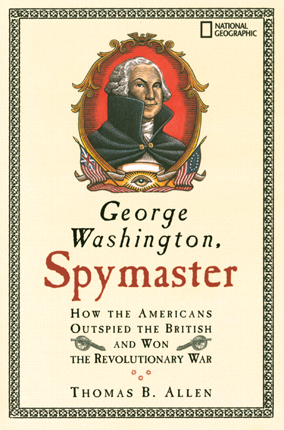Full Text Reviews: Bulletin for the Center... - 04/01/2004 Although debate continues lively over General Washington’s abilities as a battle strategist, Allen focuses his attention more narrowly on the Founder’s brilliance in establishing a standing spy ring (the Culper Ring) and running agents (both directly and through others) to gather intelligence. Although stretches of the book are military history with a bit of spying tossed in (or stretches of spying with G. W. presumably implicated, since he covered his tracks pretty well), a few chapters do detail the mysteries of invisible ink, ciphers and codes, devious hiding places for messages, clever disguises, and men and women of considerable daring. Perhaps the bookmaking itself is as intriguing as the story therein, with period-style typeface, deckle-edged paper, wryly formal chapter headings, a gallery of historical illustrations and original woodcut-styled spot art, informative endnotes, and messages that can be decoded by using Revolutionary War Major Tallmadge’s code. Coded messages convey items of information that range from teasing ("Have you figured out who the mole is?") to distracting (Allen interrupts a gripping anecdote about the arrest of a Tory spy to query, "Did you know General Washington loved cream of peanut soup?"). Despite the gimmicks, there’s some information here that isn’t readily available in other Revolutionary War histories or Washington biographies, and military buffs will want to sneak a peek. - Copyright 2004 The Board of Trustees of the University of Illinois. School Library Journal - 05/01/2004 Gr 6-9-Codes and ciphers, invisible ink and secret messages, spies and counterspies! Covert operations win the Revolutionary War under mastermind Washington in this intriguing take on early American history. Allen presents the facts with a gleeful edge, clearly enjoying his subject and writing with vigor. The author relates the main events of the Revolution chronologically, consistently revealing the shadowy role of intelligence and counterintelligence. Members of the Culper Ring, the "mole" in the Sons of Liberty, and daring women worked as spies, fighting on the secret front where Patriots and Tories looked and sounded alike. Washington's role as spymaster adds a fascinating and fresh perspective on the life of this revered founding father who did far more than cross the Delaware. This small-format book looks like a publication from the 1700s. Set in an antique typeface, it is well illustrated with black-and-white reproductions of archival art and Harness's charming pen-and-ink sketches. Messages written in the Talmadge code (1783) appear throughout, with a key in the appendix. Even the chapter titles are historically appropriate, such as "Franklin's French Friends. IN WHICH a wise man from Philadelphia goes to Paris and outfoxes spies of two nations." This is well-documented, appealing history. It's a good companion to Shannon Zemlicka's Nathan Hale, Patriot Spy (Carolrhoda, 2002), which offers similar coverage on a famous Patriot whose work as a spy cost him his life.-Joyce Adams Burner, Hillcrest Library, Prairie Village, KS Copyright 2004 Reed Business Information. - Copyright 2004 Publishers Weekly, Library Journal and/or School Library Journal used with permission. Booklist - 04/15/2004 *Starred Review* Allen, the author of Remember Pearl Harbor (2001) and books of military history, discusses espionage during the Revolutionary War in this small, distinctive-looking volume. The concise narrative traces Washington's use of spies and makes a convincing case for the pivotal role that espionage played in defeating the British. Laced with details about invisible ink, codes, and double agents, the discussion sometimes draws parallels between eighteenth-century deceptions and the methods and vocabulary of modern espionage. The black-and-white illustrations include maps, ink drawings, and reproductions of period paintings, prints, and documents. Though the small size of the pictures detracts from their effectiveness, in other respects the book's design is excellent. Period features include Caslon Antique typeface, pages with uneven side cuts, and a jacket with slightly indented type, recalling the imprints made by eighteenth-century presses. Beneath the jacket is a slightly worn, embossed cover with two secret messages written in tiny letters of code on its top and bottom edges. The extensive, informative back matter includes a time line of the war, a glossary, a substitution code used during the Revolution, notes expanding on the text, source notes for quotes, and an annotated list of recommended books and Internet sites. Handsome, unusual, intriguing. - Copyright 2004 Booklist. Loading...
|




